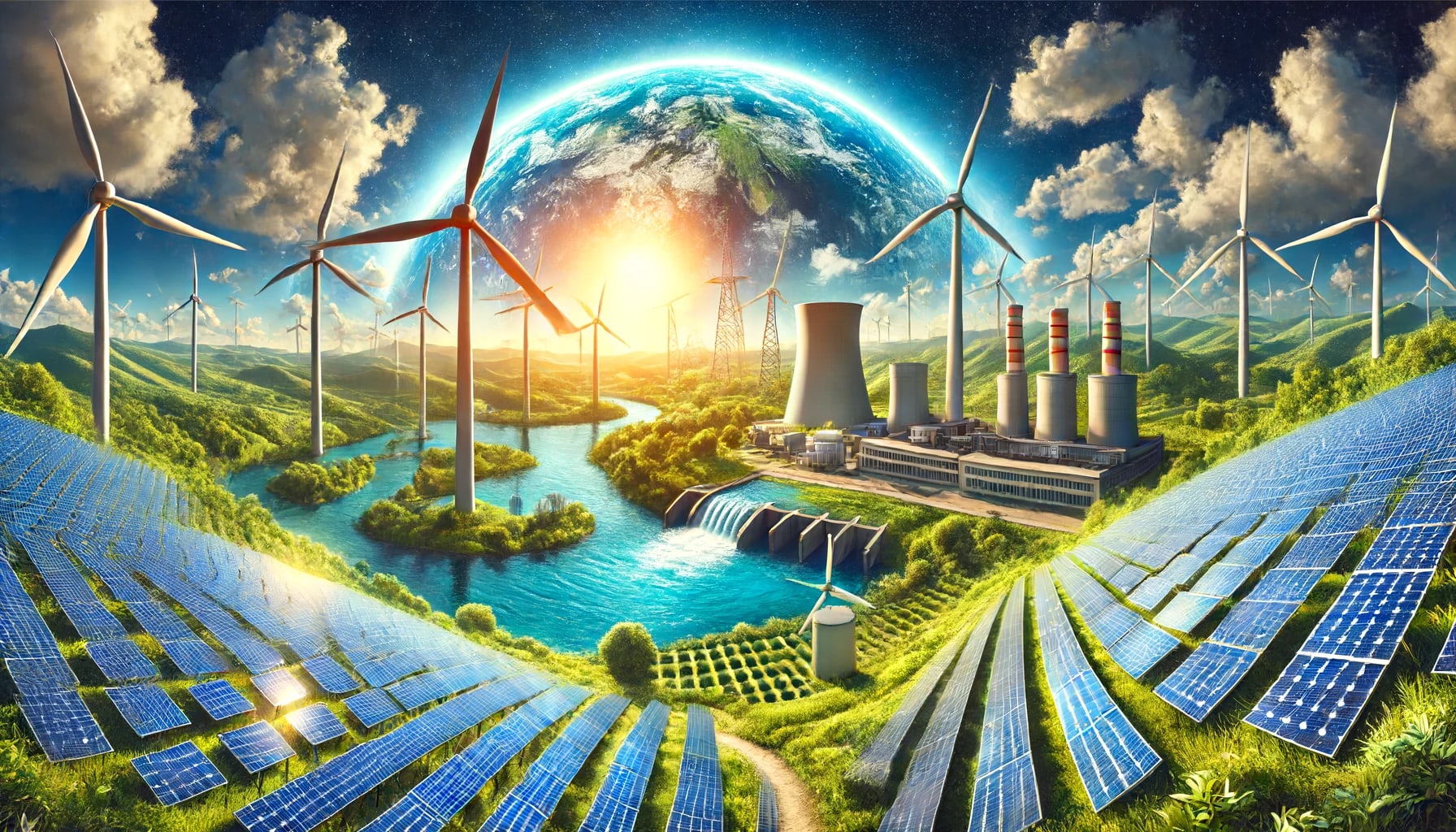Renewable energy has rapidly emerged as a key solution to the world’s growing energy demands, environmental concerns, and the urgent need to combat climate change. With the global shift away from fossil fuels, the renewable energy sector has gained significant momentum, and its potential to reshape the global energy landscape is becoming increasingly apparent. By harnessing natural, sustainable sources such as solar, wind, hydroelectric, and geothermal energy, renewable energy offers a cleaner, more sustainable alternative to traditional energy production.
In this article, we will explore how renewable energy can transform the global energy landscape, the various renewable energy sources, the benefits and challenges associated with them, and how they are shaping the future of energy consumption worldwide.
1. What is Renewable Energy?
Renewable energy refers to energy derived from sources that are naturally replenished on a human timescale. Unlike fossil fuels, which are finite and contribute significantly to greenhouse gas emissions, renewable energy sources are virtually inexhaustible and have a much smaller environmental footprint.
The most common types of renewable energy include:
- Solar Energy: Harnessed from the sun’s rays using solar panels or solar thermal systems.
- Wind Energy: Generated by converting the kinetic energy of wind into electricity using wind turbines.
- Hydropower: Derived from the energy of flowing water, typically through dams or waterwheels.
- Geothermal Energy: Utilizes heat from beneath the Earth’s surface for electricity generation or direct heating applications.
- Biomass: Converts organic materials like wood, agricultural waste, and even algae into biofuels or electricity.
2. Why Renewable Energy Matters in Today’s World
The traditional energy sector, which heavily relies on fossil fuels such as coal, oil, and natural gas, has contributed to a range of global challenges, including:
- Climate Change: Fossil fuel combustion releases significant amounts of carbon dioxide (CO2) and other greenhouse gases, which contribute to global warming and climate change.
- Energy Security: Fossil fuels are often concentrated in specific regions, making countries reliant on imports and susceptible to price volatility and geopolitical instability.
- Environmental Degradation: Extracting, processing, and burning fossil fuels causes pollution, habitat destruction, and other negative environmental impacts.
Renewable energy offers an alternative that not only addresses these issues but also offers numerous benefits to the environment, the economy, and society.
3. The Potential of Renewable Energy to Transform the Global Energy Landscape
Reducing Carbon Emissions and Fighting Climate Change
One of the most significant contributions of renewable energy is its potential to reduce carbon emissions. Unlike fossil fuels, renewable sources of energy do not produce CO2 or other harmful greenhouse gases when generating electricity. As a result, shifting to renewable energy on a global scale could significantly reduce the carbon footprint of the energy sector, which is one of the largest contributors to climate change.
By transitioning from coal and gas power plants to clean energy sources like wind, solar, and hydropower, countries can dramatically lower their carbon emissions and help meet international climate goals, such as those outlined in the Paris Agreement.
Decentralization and Energy Independence
Renewable energy has the potential to decentralize energy production. Traditional energy generation, such as coal, oil, and natural gas, typically relies on large, centralized power plants, which are vulnerable to disruptions due to technical failures, natural disasters, or political instability. In contrast, renewable energy systems, such as solar panels and small-scale wind turbines, can be installed on a residential, community, or local level, allowing for greater energy independence and resilience.
For instance, in remote or off-grid regions, solar power can be deployed to provide electricity without the need for expensive and difficult-to-maintain grid infrastructure. This decentralization can help ensure more reliable and sustainable energy access, especially in developing countries.
Economic Growth and Job Creation
The transition to renewable energy has the potential to drive significant economic growth and job creation. The renewable energy sector is labor-intensive, requiring skilled workers for the manufacturing, installation, operation, and maintenance of renewable energy systems. Solar and wind energy, in particular, have already become major job creators worldwide.
According to the International Renewable Energy Agency (IRENA), the global renewable energy sector employed over 12 million people in 2020, and this number is expected to continue growing as renewable energy adoption accelerates. Furthermore, the development of new technologies, such as energy storage and grid management systems, will create additional employment opportunities in the clean energy sector.
By investing in renewable energy infrastructure, countries can stimulate economic development, reduce unemployment, and improve local economies, especially in regions that are transitioning away from fossil fuel dependence.
Energy Access in Developing Regions
One of the most promising aspects of renewable energy is its ability to improve energy access in developing countries. In many parts of the world, access to reliable electricity is limited or nonexistent, hindering economic development, education, and healthcare services. Renewable energy, particularly solar power, can be deployed in off-grid areas to provide low-cost and sustainable electricity.
Solar home systems and mini-grids are becoming increasingly popular in rural areas of Africa, Asia, and Latin America, where conventional grid infrastructure is either too expensive or impractical to develop. These decentralized renewable energy solutions are not only affordable but can be scaled to meet the needs of different communities, helping to reduce energy poverty and promote social and economic development.
4. Challenges and Obstacles to Widespread Renewable Energy Adoption
While renewable energy holds immense potential, there are several challenges that must be overcome to facilitate its widespread adoption. Some of the key obstacles include:
Intermittency and Energy Storage
Renewable energy sources such as solar and wind are intermittent, meaning they do not produce a consistent flow of energy. Solar power only generates electricity during the day, and wind power is dependent on wind conditions. This intermittency can make it difficult to ensure a steady and reliable supply of energy.
Energy storage technologies, such as batteries, are essential for addressing this issue. By storing excess energy generated during peak production times (e.g., sunny or windy days) and releasing it when demand is high or conditions are unfavorable, energy storage can help smooth out the fluctuations in renewable energy generation. However, energy storage technologies are still expensive and require further innovation to become more efficient and cost-effective.
Grid Integration and Infrastructure
Integrating renewable energy into existing energy grids presents a significant challenge. The infrastructure of many energy grids was designed for centralized, fossil-fuel-based power generation and may not be well-suited to handle the decentralized nature of renewable energy.
Upgrading grid infrastructure to accommodate renewable energy involves significant investments in smart grid technologies, energy storage, and transmission systems. Countries will need to modernize their energy infrastructure to ensure that renewable energy can be efficiently transmitted and distributed across regions.
Political and Policy Barriers
Renewable energy adoption can be hindered by political and policy barriers, such as subsidies for fossil fuels, lack of supportive regulations, or resistance from powerful interest groups. In some countries, governments may be reluctant to invest in renewable energy due to political pressures or the influence of fossil fuel industries.
To accelerate the transition to renewable energy, policymakers must implement supportive policies, such as renewable energy incentives, carbon pricing, and subsidies for clean technologies. International cooperation and long-term policy commitment are also essential to create a stable and predictable environment for renewable energy investments.
5. The Future of Renewable Energy
Despite the challenges, the future of renewable energy looks promising, and the global shift towards clean energy is gaining momentum. Several key trends are shaping the future of renewable energy:
Technological Advancements
Advances in renewable energy technologies are driving cost reductions and improving efficiency. Solar panels, for instance, have become significantly cheaper and more efficient in recent years, making solar energy more accessible to a wider range of consumers. Similarly, wind turbines are becoming larger and more efficient, allowing them to generate more power in areas with lower wind speeds.
Innovations in energy storage, grid management, and smart grid technologies will also play a crucial role in addressing the intermittency of renewable energy and enhancing grid reliability.
Global Energy Transition
The global transition to renewable energy is being driven by international agreements, such as the Paris Agreement, which set ambitious targets for reducing greenhouse gas emissions. As more countries commit to achieving net-zero emissions by mid-century, renewable energy will be at the forefront of their energy strategies.
The Rise of Distributed Energy
As more individuals and businesses install solar panels and adopt other renewable energy technologies, the energy landscape is becoming increasingly decentralized. This rise of distributed energy systems empowers consumers to generate, store, and even sell their own electricity, creating a more flexible and resilient energy system.
Conclusion
Renewable energy has the potential to fundamentally transform the global energy landscape by reducing reliance on fossil fuels, combating climate change, improving energy security, and promoting economic growth. While challenges remain—such as intermittency, grid integration, and political barriers—the ongoing advancements in technology and infrastructure are driving the widespread adoption of renewable energy. As nations around the world continue to invest in clean energy solutions, renewable energy will play an essential role in shaping a sustainable and prosperous future for generations to come. The transition to renewable energy is not only a necessity but an opportunity to build a more resilient, equitable, and environmentally conscious global energy system.

